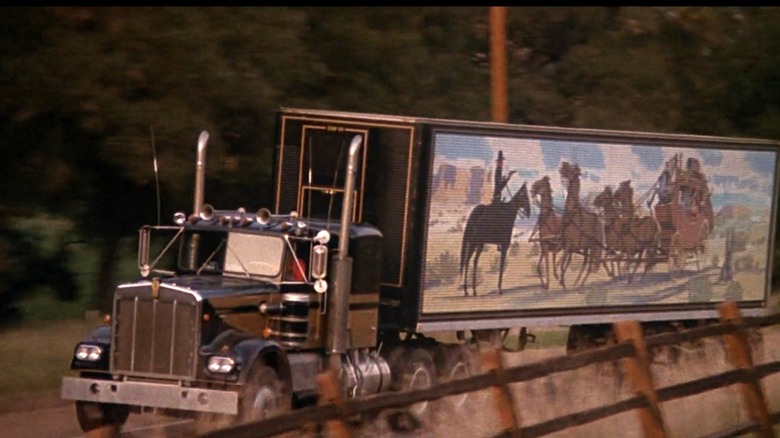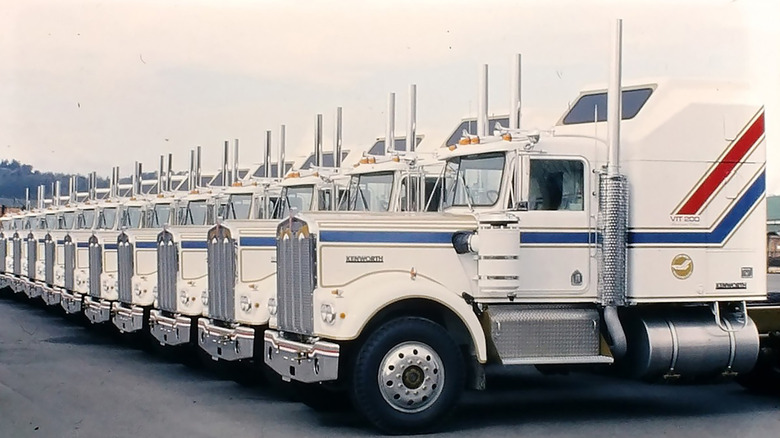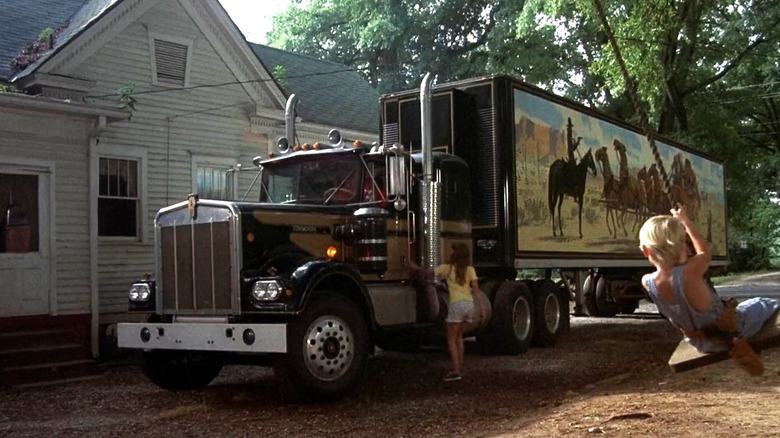What Kind Of Semi-Truck Did Snowman Drive In Smokey And The Bandit?
The 1977 movie "Smokey and the Bandit" is largely famous for two reasons: the Pontiac Trans Am driven by the titular Bandit, and the performances of the late Jerry Reed and Burt Reynolds as Cledus "Snowman" Snow and Bo "Bandit" Darville, respectively. It's a movie filled with iconic roles and outstanding performances, with even Alfred Hitchcock calling it his favorite film. But if there's one thing that stands out about "Smokey" to automotive enthusiasts, it's the vehicles.
From the pristine Trans Am and other muscle cars to street rods to classic and modern (for the 1970s) big-rigs and everything in between, this movie revels in automotive culture. There's no questioning the level of impact that the 1977 Pontiac Trans Am left in its wake, but what about another more unsung hero? Namely, the entire reason for the movie's premise in the first place: Snowman and Bandit's truck.
This truck was a 1974 Kenworth W900A belonging to the Bandit and driven by Snowman, around which the plot of the movie hinged. As a quick refresher, Bandit was given a task to transport 200 cases of Coors from Texas to Georgia in 28 hours. Since it was considered illegal at the time to sell Coors east of the Mississippi, Bandit requests a "blocker" car – something to distract the police and keep them off the scent of the Kenworth: namely, the Trans Am. This makes the entire back-half of the movie largely just one long police chase, cementing the Trans Am in automotive history – but let's not forget the true understated hero of the film.
Kenworth W900A: A legend in the trucking world
The Kenworth W-line ("W" standing for "Worthington") is likely what comes to mind when people picture an American big-rig, and rightfully-so; these days, few nameplates carry as much weight (pun not intended) as the W900. Kenworth kept this rig in continuous production for over 60 years, though the company sadly announced the W900's official retirement for the 2026 model year. Today's W900 utilizes square headlights, first introduced with the W900B in 1982, which is the easiest method for the layperson to tell an "older" from "newer" model. But aside from similarly minor changes along with more advanced technology and powertrains, these trucks hardly evolved throughout the entire lineage. To put it in perspective, the W900's unchanging image and immense lineage rivals that of the original Volkswagen Beetle. and a testament to the popularity of the brand among many fantastic options available in the United States.
The W900 was introduced in 1963 as the latest in Kenworth's conventional-cab truck line dating back to 1939, namely the 500-series. Much of the original truck's DNA carried over to the W900, with the latter taking what worked with the 500 and scaling it up. The W900 boasted a higher roof line, widening of the radiator, fender-mounted headlights, and more. It received its first upgrade package in 1967, resulting in the W900A which stars in "Smokey and the Bandit." As opposed to the standard W900, the W900A featured a longer hood to accept larger-displacement engines and an even larger radiator to help keep those engines cool.
The true star of Smokey and the Bandit
The W900A starring in the movie was a 36-inch sleeper cab variant, with three trucks used in filming: a 1973 and two 1974 models – although other sources differ on specific years. The 1973 model was actually a 50th-anniversary edition sporting a gold hood emblem, displayed during various scenes (possibly because it matched the livery). The truck used during the finale, however, features a silver emblem and custom bullbar when it rams the police cars out of the way. So these more action-oriented shots likely feature one of, or both, of the 1974 trucks, whereas the "hero shots" displaying the emblem use the gold ornamentation.
The W900 enjoys several prestigious honors in "Smokey and the Bandit," serving as both a central plot device and a filmmaking tool. The movie immediately centers around the truck from the very first shot, with the entire introduction being a montage featuring Bandit's W900A, and most opening scenes prominently showcasing the truck. The painted trailer's vivid portrayal of an Old Western bandit holding up a stagecoach serves as both a clever foreshadowing device for the movie's themes and a gorgeous piece of art in its own right.
However, actual hard evidence is sorely lacking on these rigs. The only inferences we can make are which trucks were used at what point during filming. Aside from that, nobody even knows where any of them are located, though many faithful replicas exist that carry on their legacy. However, the famous mural trailer is actually still around, recently exiting its retirement to star as an Easter egg in the TV show "The Walking Dead."


